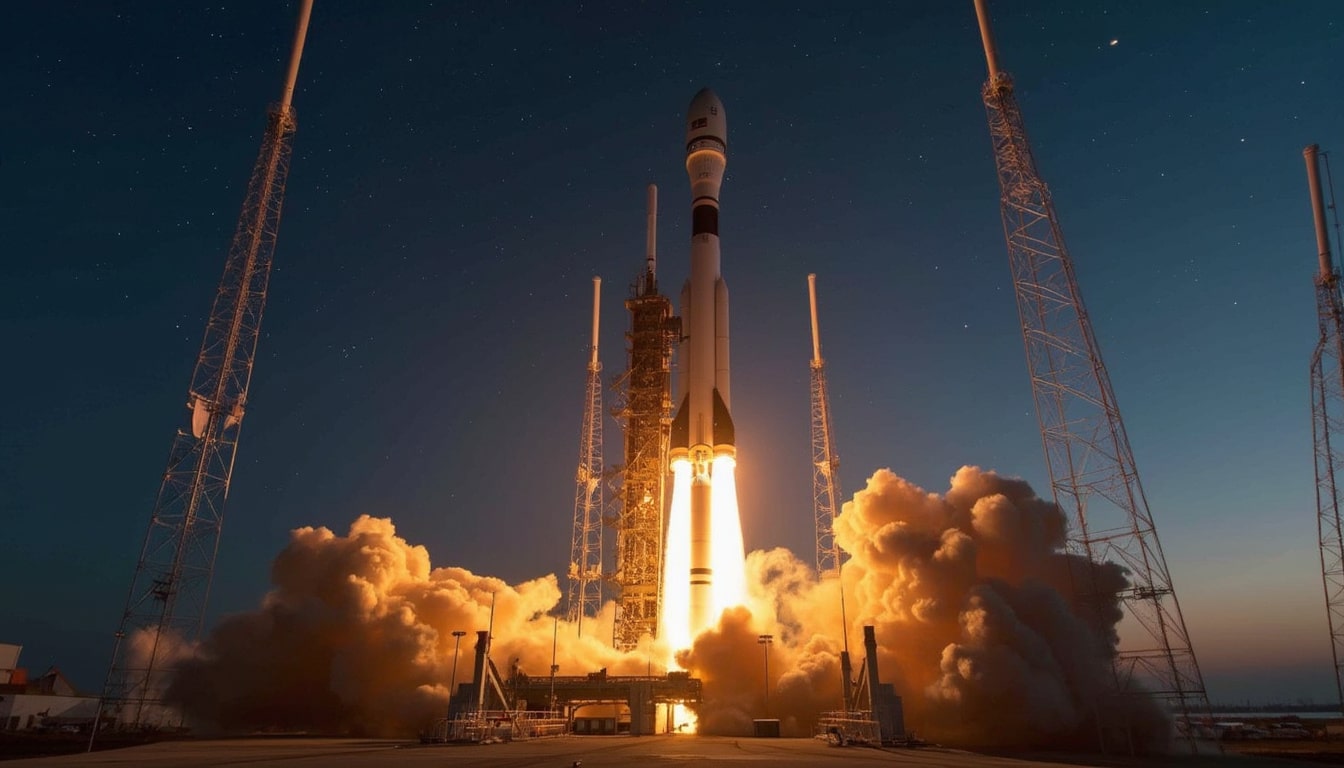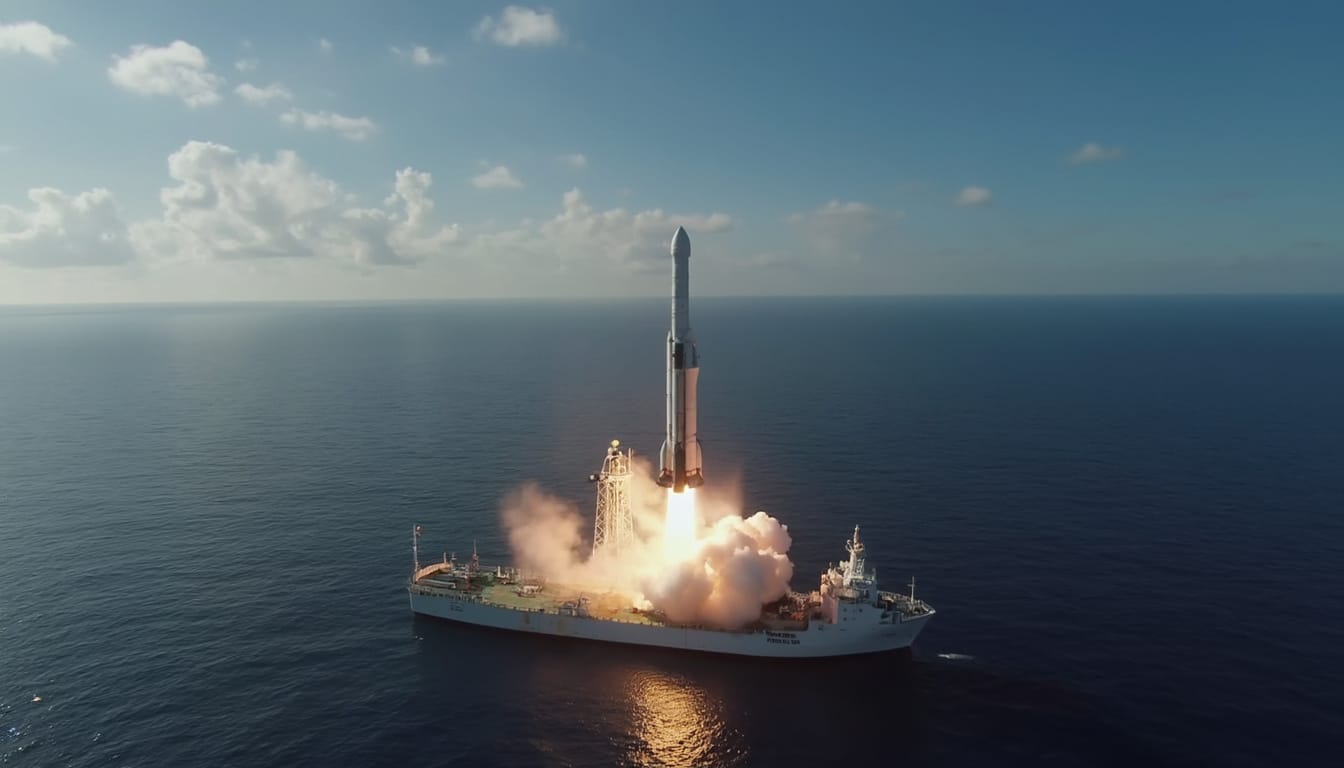On a recent evening in March, SpaceX, the revolutionary aerospace company led by Elon Musk, successfully launched a Falcon 9 rocket featuring a batch of 21 new Starlink broadband satellites into orbit. The launch, which took place at Cape Canaveral Space Force Station in Florida, marked a significant milestone for SpaceX as it continues to expand its role in the global satellite communications industry. Among the satellites deployed, 13 are equipped with cutting-edge direct-to-cell technology, which has the potential to transform mobile connectivity by allowing smartphones to connect directly to satellites. With growing momentum in their mission to provide universal internet coverage, the launch further cements SpaceX’s position at the forefront of space technology innovation.
As the Falcon 9 rocket soared into the evening sky, it lit up the darkness, creating a spectacular view that was witnessed by many. Following a flawless ascent to low Earth orbit, the rocket’s impressive first stage returned safely to the ocean aboard SpaceX’s drone ship, “A Shortfall of Gravitas.” This launch was the 22nd for this specific booster, showcasing the reusability aspect that SpaceX champions to reduce costs and waste associated with spaceflight.
With this launch, SpaceX has now deployed nearly 8,100 Starlink satellites, with over 7,000 still operational in low Earth orbit, underscoring their commitment to bridging the digital divide and enhancing broadband capabilities worldwide. As exciting as the deployment was, it was also noteworthy that this launch came amid preparations for SpaceX’s upcoming Crew-10 mission for NASA, demonstrating the company’s ability to juggle multiple ambitious projects simultaneously.
Overview of the Launch Including Key Details
The successful launch of the Falcon 9 rocket occurred at precisely 10:35 p.m. EDT on March 12, 2025. The rocket’s trajectory took it straight upward, utilizing the power of its nine Merlin engines to climb rapidly against the earth’s pull. Approximately 8.5 minutes post-liftoff, the booster completed its vertical descent, ultimately splashing down on the drone ship, thereby continuing SpaceX’s legacy of successful reusability. Satellite deployment occurred seamlessly as the upper stage executed its tasks proficiently, confirming that all 21 satellites were positioned correctly in their intended orbits.

Technical Objectives and Innovations of Starlink
Starlink is not just about sending satellites into space; it represents a revolutionary approach to global communication. With each launch, SpaceX continues to enhance its broadband technology, targeting areas of the world that traditionally struggle to access high-speed internet. The inclusion of the 13 direct-to-cell satellites is particularly notable, as this innovation allows for users without traditional internet infrastructure to connect directly to satellites in orbit. This capability could prove crucial for delivering internet services to remote locations and during emergency scenarios.
The Starlink proliferation strategy revolves around creating a “constellation” of satellites operating in low Earth orbit. By doing so, the latency is significantly reduced compared to traditional internet services relying on ground-based connections. User experiences are enriched through consistent updates to the service that aim to improve performance and expand coverage areas. As of now, over 20 Starlink launches have been executed in 2025 alone, with plans for more in the coming months. The resilience of SpaceX’s launch capability has also been on display through their ability to quickly reschedule missions following unforeseen circumstances, like the recent delays affecting the Crew-10 astronaut mission.
Environmental Considerations and Future Directions
While the launch of broadband satellites such as Starlink brings incredible advancements in connectivity, it does prompt discussions about our responsibilities to the environment. SpaceX has made significant strides in addressing these concerns by introducing features that reduce the likelihood of space debris. The design of Starlink satellites allows for controlled deorbiting at the end of their operational lives, mitigating their impact on the space environment. SpaceX’s commitment to sustainable spaceflight practices signifies a forward-thinking approach that other aerospace companies should consider adopting.
Moreover, as Starlink expands its service offerings, particular attention is given to the regulatory landscape surrounding satellite communication technologies. SpaceX diligently works with entities like the Federal Communications Commission (FCC) to ensure all required permissions are in place to offer these groundbreaking services. As they pave the way for direct-to-cell technology, SpaceX is also navigating the potential challenges posed by international satellite operations and competing services.

The Global Impact of Starlink Services
The implications of Starlink’s capabilities extend beyond sheer technological advancements; they have the potential to change access to information and connectivity across diverse regions of the globe. Developing countries and remote areas have historically struggled with internet access, significantly affecting education, economic growth, and social connectivity. By setting up satellite systems that can provide reliable service in these locations, SpaceX may help to democratize access to the internet.
Various nations have expressed interest in utilizing Starlink for applications ranging from telehealth services to improving agricultural practices through better access to information. This increasing demand provides SpaceX with numerous opportunities to engage with governments and private sector players. As partnerships unfold, communities across the globe may begin to see increased connectivity, providing myriad benefits that align with digital transformation worldwide.
Community Engagement and #StarlinkUpdates
SpaceX actively engages with its growing community of users and enthusiasts. The company leverages social media platforms to provide updates on services, launches, and user experiences with Starlink connectivity. By utilizing these channels, including Twitter and Facebook, SpaceX fosters a sense of shared experience and excitement with every successful mission.
This recent deployment has attracted significant media attention as it underscores the relentless pursuit of innovation by SpaceX. Through engagements and updates, customers and ambassadors share their experiences, shaping the narrative around Starlink’s capabilities. As more regions gain access to service, the conversation surrounding broadband around the globe intensifies, with users expressing both excitement and curiosity.
What’s Next for SpaceX and Starlink
Looking ahead, SpaceX’s path seems ambitious yet achievable. With multiple planned launches, the expansion of Starlink services into new regions is likely inevitable. Further innovations in satellite technology may enhance user experiences, while continued engagement with regulatory bodies will smooth the path for operational expansions. Moreover, strategic partnerships can catalyze additional applications, solidifying Starlink’s viability as a solution to the digital divide.
| Launch Date | Number of Satellites | Satellite Type | Location | Status |
|---|---|---|---|---|
| March 12, 2025 | 21 | Starlink Broadband | Cape Canaveral, Florida | Success |
| March 14, 2025 | 4 (Crew-10 Mission) | NASA’s Crew Module | Kennedy Space Center | Scheduled |
| April 2025 | Starlink Batch | Broadband Satellites | Florida Launch Site | Upcoming |




Leave a Reply